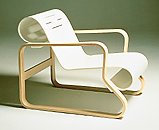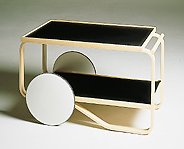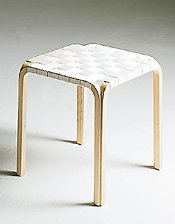|
Alvar Aalto - designer and architect at Luebeck
This small exhibition
<http://www.aalto-ausstellung.de/>, in the nave of St. Petri - that is one of the largest and most beautiful churches of Luebeck - may suggest a different point of view on the work of Alvar Aalto Pause for a moment in front of one of his innumerous and extraordinary inventions and ask yourself how this Finnish architect, being famous in lifetime, and named together with Le Corbusier, Gropius, Mies and Wright, could possibly have been set apart in a dark corner of history ?
It's not meant irreverently, to say that the products of a renowned and famous Swedish factory - known, too in Italy, along with many other furniture-manufacturers coming from the same meridians- should have taken Aalto to more popularity, considering that the majority of so-called Scandinavian furniture is still based on his characteristic style.
In the nave of St. Petri's Church at Luebeck, on an inclined plane you see different wooden chairs. Stools and armchairs, either as an original or as a remake, all make a fine showing of themselves, most elegant, straight and sober, putting Aalto side by side with the formal rigorism of rationalism still valid in our days. Evidently it is not surprising at all that this furniture is still being produced thanks to the same manufacturer founded in 1935 by Aalto and some other architects. "Artek" of Helsinki, sponsor of the exhibition, issues a very simple, but exhaustive commercial catalogue showing both Aalto's and his wife's Aino Aalto's best design-products.
Probably because of our sensitivity too spoiled by three dimensions, by colours, by the ease of taking a look at something and of reconstructing it that you leave this exhibition remembering mostly the birch-wood furniture distinctly formed and not the desks with all the projects i.e. the very complete drawings of the big construction at Wolfsburg, nowadays a cultural centre named after its creator. Architecture on paper is being subordinate to the sculptural quality of real forms.
It's worth while to analyze the designer's Aalto projects without forgetting the extraordinary working quality of all the furniture manufacturers-craftsmen of passed times. Beginning with some number attributes to the French Kings Louis, passing the Chippendale-Englishmen, and ending up with Thonet, the crucial inventor of curved beech-wood. Therefore I have chosen, in the limits of Aalto's work as a furniture-designer (this form of the applied arts becoming prestigious at the beginning of the last century with the inventions of Rietveld and Breuer), four models listed in the catalogue as 41, 901, 406 and Y61.
Armchair Paimio 41

Designer Alvar Aalto 1935-36
- Birch
- Top material: black linoleum or white iki laminate
This is most probably the best known chair by Aalto. It was predestined to the Sanatorium of Paimio and represents a kind of rival project to the very famous Wassilj by Marcel Breuer where steel tubes had replaced wood. The sobriety of both objects is undoubted even if Aalto's project seems to be accentuating the wooden curves according to a formal model. Typical, too, for the architect Aalto: as curves are psychologically more acceptable than right angles. Against tradition this armchair confirms the rationalistic abolition of cushions and upholstery in favour of an anatomic bending and use of a cheap industrial material such as birch-plywood. The birchwood-structure instead is obtained by curved layers that can hold the weight because of their flexibility and elasticity. Nevertheless, Aalto hasn't yet found the solution to lighten the form in its totality, which seems cumbersome even if nearly transparent. It will be with the armchair 406 and its courageous sudden change in structure that our designer will bring his formal and structural research to a logical conclusion.
Tea Trolley 901
 Designer Alvar Aalto 1935-36
Designer Alvar Aalto 1935-36
- Birch
- Top material: black linoleum or white iki laminate
This trolley is only fitting the formal choices of the armchairs, the stools and the chairs. The birch-skeleton and the monochromatic levels are essential; the abolition of right angles in favour of smoothed curves makes the object three-dimensional and evasive at the same time. The strongest formal aspect is however to be found in the monochromatic wheels without spokes, inserted in the straight context of the structure, as a very strong pictorial element of composition.
Armchair 406

Designer Alvar Aalto 1938-39
- Birch
- Upholstery options: Webbing, quilted canvas, quilted leather, leather belts
Since the time of the 19th century revolution of Thonet and his curved wood (which remains, however, the indisputable prototype of all modern chairs), probably no other structural model has had as much success as this one. A curved open element, that bears weight thanks to its proper elasticity, is bending itself because of accurately calculated limits; the seat is aligned incredibly backwards compared to the vertical part of the structure and although it is not rigid but made of interlaced strips of cloth or leather. The courageous straightness of the armchair 41 Paimio is here reaching its coherent opening to an absolute lightness of form.
Stool Y 61
 Designer Alvar Aalto 1946-47
Designer Alvar Aalto 1946-47
- Birch
- Seat options: Webbing, rattan, quilted canvas or leather
Stackable
The other furniture produced by Artek have probably had a major effect on us. They seem to have undergone a deeper aesthetic research, but this stool almost disarming in its simplicity displays the primary characteristics of the designer Aalto: functional and practical but also very likely to be accepted by our senses and our taste.
The formal detail of the smoothed angle which meets the seat's strips looks nearly like an abstract painting; the functional characteristic of being stackable thanks precisely to these formal details turns this object into a small masterpiece of industrial design meant as it should be.
In the Web
<http://www.hut.fi/~mniskane/aalto/runko.htm>
<http://www.jkl.fi/aalto/>
<http://www.moma.org/exhibitions/aalto/>
<http://www.greatbuildings.com/architects/Alvar_Aalto.html>
<http://www.publiscan.fi/cu08e-8.htm>
Books (Italian)
Mangone, Fabio; Scalvini M. Luisa
Alvar Aalto
Laterza, 2000
Aalto, Alvar, Alvar Aalto. Nuovi dialoghi di architettura, Compositori, 1999.
Sui luoghi di Alvar Aalto. Architetture finlandesi, Kappa, 1999.
Alvar Aalto, Rizzoli, 1998.
Alvar Aalto 1898-1976, Electa, 1998.
Alvar Aalto. Visioni urbane, Skira, 1998.
Keinamen, Timo - Alvar Aalto: il padiglione finlandese alla Biennale di Venezia, Electa, 1996.
Aalto Alvar, Idee di architettura. Scritti scelti (1921-1968), Zanichelli, 1987.
|
